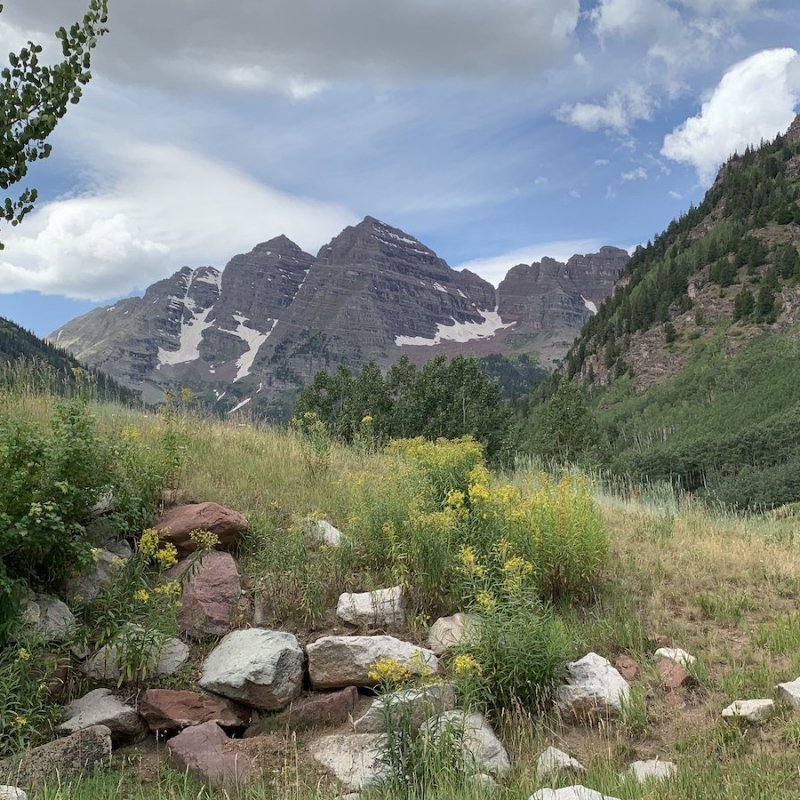
Sandi Barrett
Spectacular mountain vistas that seem to change color as the sun angle shifts, vast fields of wildflowers dancing in the gentle breeze, aspen trees standing straight and tall, and crystal clear mountain lakes that mirror their surroundings; Colorado’s Maroon Bells are a must-visit if you are in Aspen.
Videos by TravelAwaits
Renowned for its acclaimed skiing and celebrity sightings, Aspen is home to the most iconic 14,000 footers (14ers) in Colorado, the Maroon Bells. Touted by many as the most photographed peaks in North America, once you experience their beauty, you will certainly agree. When you stand alongside Maroon Creek and gaze across the landscape, the towering Maroon Bells are a breathtaking vision of crimson and pink against a beautiful blue sky.
Hit The Trails
Hiking the iconic Maroon Bells area, whether you are a beginner or expert trailblazer, is an experience that will stay in your memory banks forever. Unlike any other hike, Mother Nature provides her Maroon Bells visitor with awe-inspiring scenery and sets a perfect stage for gorgeous photos. Even amateur photographers will have magazine-ready photos. It is impossible to take a bad picture surrounded by such gloriousness.
Easy trails include the Maroon Bells Scenic Loop Trail. If you take the bus to the Maroon Bells Welcome Station, the trailhead is easily accessed from the parking lot. This 1.9-mile, easy loop trail takes you out past Maroon Lake and back. It offers breathtaking scenery on this approachable short hike that has minimal elevation gain.
A moderately rated, out-and-back hike that is also accessible from the welcome station is Crater Lake Trail. This trail takes you out past Maroon Lake, through the natural landscape, and out to Crater Lake. The 3.8-mile trail will challenge you with distance, but the hike is pleasant and scenic with only a slight elevation change of under 700 feet.
As of this writing, Four Pass Loop is the number-one-rated trail in the Maroon Bells-Snowmass Wilderness by AllTrails hiker reviews. This 27.1-mile, difficult-rated backpacking trail is best saved for very experienced hikers. The loop takes you up four mountain passes; West Maroon at 12,500 feet, Frigid Air at 12,415 feet, Trail Rider at 12,420 feet, and Buckskin at 12,500 feet. This hike requires planning and a solid knowledge of the area’s terrain.
West Maroon Bells Pass is a popular 7.8-mile, difficult-rated trail that offers hikers and backpackers stunning views. Be prepared for a serious elevation gain of 2,165 feet. The trailhead is accessible by high-clearance 4×4 vehicles only.
It is strongly advisable to set out early in the morning, as thunderstorms are prevalent in the afternoon and you want to be off the peak at that time. Satellite phones are recommended if you are planning long and overnight hikes. They are necessary emergency equipment if you run into trouble and need to contact Mountain Rescue.
When you have finished hiking the Maroons Bells, check out these other amazing Colorado hikes: the nine most stunning hikes in Colorado.

Maroon Creek Camping
Summer season camping at Maroon Bells is a wonderful, nature-immersive experience. The sites are open May to October, and reservations are required. Campsites have a five-day stay limit.
Silver Bell Campground is the largest campground and is located at 8,460 feet. It offers 14 sites on the banks of beautiful Maroon Creek. This popular campground offers a few first-come sites, but they book up early. They also have RV and trailer sites along with the classic tent site. There are no hookups, and campers must be self-contained.
Silver Bar Campground is a primitive campground with four sites available on the banks of Maroon Creek. This is a pack-in, tent-only campground that is close to the action at the Maroon Bells Welcome Station. The Silver Bar is an excellent place to stay; you don’t have to carry your equipment very far from the parking lot, and you still have access to everything the Maroon Bells has to offer. Open May through October, there is a five-day limit, and reservations are required.
A very popular campsite, Silver Queen Campground has five sites located near Maroon Creek. With an elevation of 8,700 feet, you are still a good climb away from the summit and the views. The campground is accessible to trailers and RVs and makes a great base camp for day hikes. Reservations are required, and there is a five-day stay limit.
If you are interested in a more luxurious stay, visit any one of these 12 gorgeous luxury vacation rentals in or near Aspen.
Hire An Expert Guide
Hiring a professional guide service for extended and more involved hikes is a smart choice when visiting the Elk Mountains near Aspen’s Maroon Bells. There are seven 14ers in this range, and hiking them unprepared can be dangerous.
For the intrepid hiker, Aspen Alpine Guides offers half-day, full-day, and extended guided hiking tours geared to your skill level. Hiking with a trained and experienced guide is an investment in your skill development. The wisdom of these seasoned trekkers impart will carry over to all your other hiking adventures.
Fun In The Winter
The access road is closed during the winter, but you can still experience the Maroon Bells in all their snowy winter glory with a snowmobile tour: T-Lazy-7 Ranch’s Snowmobile Tour. They offer group and private tours where you ride on groomed trails through the brilliantly white, snow-covered landscape punctuated by sentry-like, dormant white aspen tree trunks. To experience this adventure with the peaks blanketed in snow and Maroon Creek crystal-like in the winter weather is an adventure you won’t soon forget.

To Hike Or Climb?
Climbing the Maroon Bells is an entirely different adventure than hiking a trail. It should not be attempted unless you are a very experienced climber. Nicknamed the “Deadly Bells” by climbers, they rank as some of the most dangerous 14ers in the state.
The Maroon Bells are made from hardened shale, which is fragile in nature. The rock breaks and fractures easily making footing unstable and rockslides commonplace. Risky and unpredictable, climbing should be left to the fearless and sure-footed.
Enjoy your hike on a well-traveled and marked trail for the safest visit to these iconic mountains.
Their Maroon Color
When the sun moves across the Colorado sky, the Maroon Bells go from soft gray to shades of red, pink, and purple. Oxidized iron particles in the rock give the bells their unique maroon color. The red shale and siltstone form the fragile rock face and present their red hues.
Below the shale rock are large pink crystals called phenocrysts. The combination of these rocks comes together for a changeable, highly photographed maroon mountain. (This geological information was sourced from the United States Department of Agriculture. Here’s more information [PDF], if you’re interested.)
Altitude Sickness Is Real
Maroon Bells Welcome Station is at 8,458 feet, giving you a good starting elevation for your hikes. When you arrive at the welcome station parking lot, take some time to acclimate to the altitude. Wander down to the lake, take some photos, and enjoy the gorgeous views. Taking time to literally “catch your breath” will help get your hike off to a great start.
Altitude sickness is something you need to consider whenever you are hiking in the mountains. Particularly when you are in Colorado. According to WebMD, the altitude sickness phenomenon is caused by the drop in air pressure resulting in less oxygen as you gain altitude. When you are over 8,000 feet, you can experience symptoms such as mild dizziness, headache, and shortness of breath. These symptoms will dissipate as you acclimate to the altitude. More severe responses like nausea, vomiting, and trouble walking require medical consultation.
Combat altitude sickness by avoiding alcohol, drinking plenty of water, including complex carbs in your diet, and add hiking altitude slowly each day. If you feel a bout of dizziness coming on, take a break and enjoy the scenery while your body has a chance to regroup.
How To Get To Maroon Bells
From mid-June to early October, Maroon Creek Road, which takes you to the Maroon Bells Welcome Center and Maroon Bells Trailhead, is drivable. You are allowed to drive your personal vehicle, for a small fee, before 8:00 a.m. and after 5:00 p.m. Between 8:00 a.m. and 5:00 p.m., visitors are required to take the Roaring Fork Transportation Authority (RFTA) bus. Park in the Aspen Highlands and purchase your bus ticket at the Four Mountains Sports Shop. For up-to-the-minute shuttle and parking information, visit RFTA Maroon Bells.
White River National Forest
The Maroon Bells scenic area comes under the supervision of the United States Forest Service and is located in the White River National Forest. The White River National Forest covers over 2.3 million acres, including eleven ski resorts, eight wilderness areas, ten 14ers, and 2,500 miles of hiking trails. They are your go-to website for all information you need to visit safely.
Enjoy your trip to the beautiful Maroon Bells. Even if you don’t want to hike the area, take the bus up and stroll around the lake or find the perfect spot and have a picnic. If you want to learn more about Colorado’s 14ers, particularly the seven in the Elk Mountains, visit 14ers.com.
